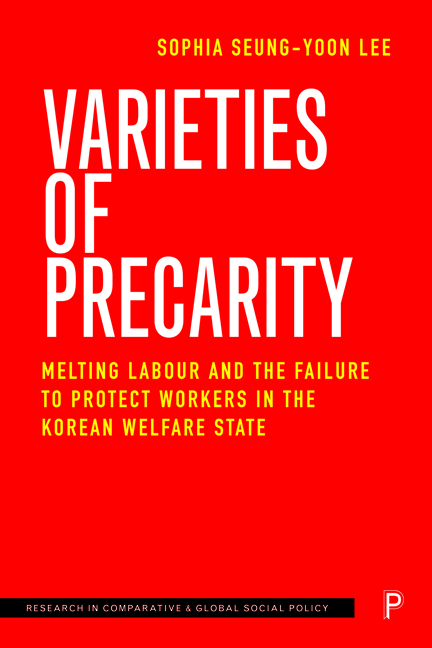 Varieties of Precarity
Varieties of Precarity Book contents
- Frontmatter
- Contents
- Series editors’ preface
- List of figures and tables
- Acknowledgements
- 1 Introduction: Melting labour and institutional inconsistency
- 2 Social protection policies and the South Korean labour market in comparative perspective
- 3 When insiders are kicked out: layoffs of regular workers in manufacturing
- 4 Same boat, different destiny: subcontracted workers in the Korean shipbuilding industry
- 5 Young and old outsourced female workers in call centres and cleaning services
- 6 Are freelancers really free? The Korean freelance labour market and the precarity of young freelancers
- 7 The digital precariat: various Korean platform workers and the new work logic
- 8 Conclusion: Towards universal institutional protection for precarious workers in the era of melting labour
- Notes
- References
- Index
3 - When insiders are kicked out: layoffs of regular workers in manufacturing
Published online by Cambridge University Press: 03 April 2024
- Frontmatter
- Contents
- Series editors’ preface
- List of figures and tables
- Acknowledgements
- 1 Introduction: Melting labour and institutional inconsistency
- 2 Social protection policies and the South Korean labour market in comparative perspective
- 3 When insiders are kicked out: layoffs of regular workers in manufacturing
- 4 Same boat, different destiny: subcontracted workers in the Korean shipbuilding industry
- 5 Young and old outsourced female workers in call centres and cleaning services
- 6 Are freelancers really free? The Korean freelance labour market and the precarity of young freelancers
- 7 The digital precariat: various Korean platform workers and the new work logic
- 8 Conclusion: Towards universal institutional protection for precarious workers in the era of melting labour
- Notes
- References
- Index
Summary
‘Even if you climbed all the way up to be a Meister in a large company if you are fired, that’s the end of the world.’ (A temporary worker dismissed from a large company)
The dual labour market in Korea
This chapter presents a case study on SsangYong Motor, one of the largest automobile manufacturers in Korea, to examine the experiences of its regular workers after being laid off. The study reveals how standard manufacturing workers, who were once considered insiders in the dual labour market, fall into the outsider category due to weak institutional protection. The case study represents cell 2 in the two-by-two matrix explained in Chapter 1, which includes wage workers who are covered by institutional protection, such as regular workers in large corporations and the public sector, who are considered labour market insiders. Victims of the 2009 SsangYong Motor layoffs experienced a sharp decrease in their income immediately after the layoff and were drifting from one unstable job to another, such as outsourcing, daily labour and micro-scale self-employment. In this chapter, I highlight the issue of old precarity, where workers with stable employment status can easily slide into precarious work once they lose institutional protection.
The dual structure of the Korean labour market has been discussed since the mid-1980s in Korea, mainly driven by the dual labour market theory (Lee H.S., 1984). A significant body of research has pointed out the dual structure of the Korean labour market in various ways. The related studies can be largely divided into three categories according to the criteria for classifying the dual structure of the labour market.
Studies in the first category have examined the formation of a dual structure in job stability and wage level (Lee J.H., 1992; Jeong E.H. and Jeon B.Y., 2001; Jeong E.H., 2002; Beck S.H., 2014; Lee S.Y., 2016). According to these studies, there exists a dual structure in the Korean labour market in terms of wage and employment protection depending on employment status and company size.
- Type
- Chapter
- Information
- Varieties of PrecarityMelting Labour and the Failure to Protect Workers in the Korean Welfare State, pp. 57 - 75Publisher: Bristol University PressPrint publication year: 2023
